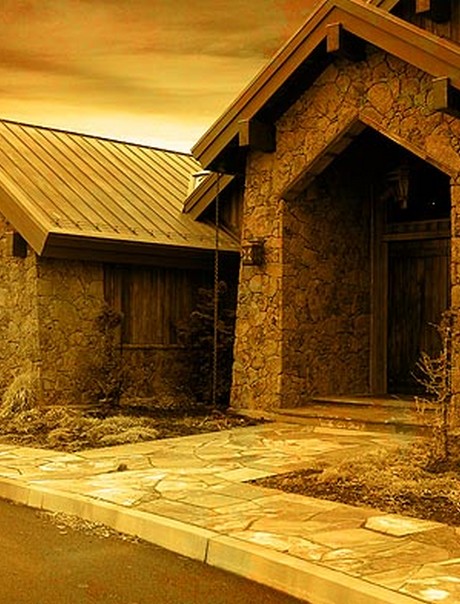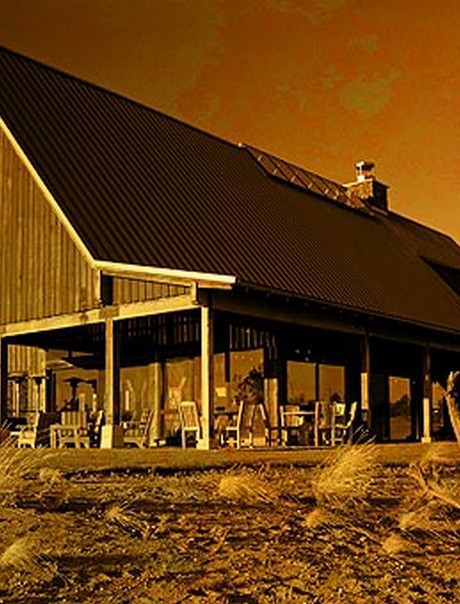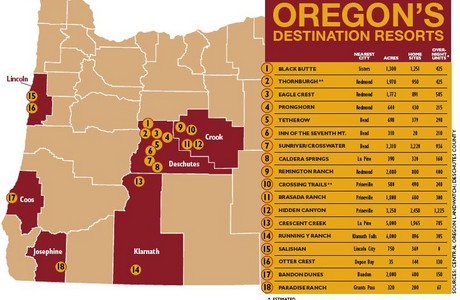Once-golden destination resorts face uncertain future in Central Oregon
Perhaps it’s my background (having worked at the start up/early development of Pronghorn, Brasada Ranch, and Tetherow), but I found the following article written by Robin Doussard in Oregon Business to be incredibly insightful, and, unfortunately, right on the mark. A superb analysis of some of our housing woes. I’m even a little surprised at quotes by some of the principles.
Remington Ranch
The expansive sales office at Remington Ranch in Powell Butte sits empty and shuttered, mostly bare inside except for a large relief map of what the 2,080-acre destination resort entailed when it was approved in 2006 by Crook County: 800 homes, 400 overnight units, three golf courses, retail shops and several restaurants.
That was the plan before the housing market began its freefall in 2007 and Remington shut down sales the same year. It was before Crook County voters in 2008 voted for a moratorium on large destination resorts. And it was before Remington Ranch filed for bankruptcy this January.
But to Chris Pippin, the resort’s youthful Stanford-educated project manager and son of James Pippin, Remington’s managing member, the promise is still there. As he tours the scrubby high-desert landscape on a cold early-spring day, pointing out one golf course that is 75% complete, Pippin sees a future for Remington: Moneyed baby boomers will keep retiring, the Central Oregon sun will keep shining, and as luck would have it, Crook County “closed the door behind us.” That door was shut after four resorts had been approved: Brasada Ranch, Hidden Canyon, Remington Ranch and Crossing Trails, a combined 7,700 acres and 6,500 overnight and home units.

“In some ways it is a positive that we didn’t get too far down the road with a product we couldn’t sell,” Pippin says, referring to the 800 unbuilt homes. He’s looking for a big push in sales in spring 2011 once Remington comes out of bankruptcy reorganization.
Pippin may or may not be right about the future of his property, which Winchester Development paid $10 million to acquire. He could be the only upbeat developer left in Oregon. Maybe it is the required optimism of any developer talking to the press these days, much less one whose dad has skin in the game as one of the property’s owners.
But he does have one thing right. The door has closed — if not forever than at least for a good while — on the large resorts with hotels, golf courses and homes that dot the state and blanket Central Oregon. It’s a once-coveted business that’s in trouble with regulators, residents, environmentalists and the development industry. It’s a business under fire and in flux, and one with an uncertain future.
Brasada Ranch
Jerry Andres, president and CEO of Jeld-Wen Development, is blunt and unequivocal:
“Destination resorts are done in Oregon.”

The forensics find the patient suffering from multiple wounds, some self-inflicted: the housing collapse, the subsequent recession, greed, need, bad timing, poor planning, overbuilding, speculation and more than a bit of magical thinking. The law of unintended consequences plus the economic collapse has spared no one. Most of the state’s destination resorts are in various stages of distress: slowed sales to no sales to foreclosures to bankruptcy.
The landscape is littered with foreclosures (currently more than 6,000 in Deschutes County alone), and the housing market in Central Oregon is woefully oversupplied. “Just in Deschutes, you have 15,000 approved lots,” says resort consultant Linda Swearingen.
National housing expert John McIlwain has seen it before: “One of the things the development community is really good at is spotting an opportunity and then overbuilding it.”
And then there’s the long-standing criticism that newer resorts are stealth subdivisions that circumvent land use rules and provide only low-paying jobs and few of the public amenities that create tourism, which is why they were allowed to build in rural areas in the first place. There is growing opposition from Oregonians, legislators, the environmental community, and increasing alarm from nearby cities, which have no say over the approval of resorts. Cities do not share in the tax rewards that go to the counties (in 2008-2009, Deschutes County resorts paid more than $35 million in taxes), which approve the resorts. But cities have to cope with the impact they have on their services, roads, infrastructure and housing stock. Redmond, for instance, is having difficulty attracting high-end housing because of the nearby resorts, which limits its property tax revenues, according to the League of Oregon Cities.

It will take years, if not decades, to soak up the current supply of real estate and recover prices. Residential property in Bend has fallen 75% from 2007 top prices, and commercial property values are half off their peak. A federal housing study released in late May showed that Bend suffered the sharpest housing price drop in the nation over the past year. Roger Lee, executive director of Economic Development for Central Oregon, has little sympathy. “The reset had to happen,” he says. “Prices were too high.”
Even the mighty Jeld-Wen, Oregon’s largest privately held company, is hurting. A major player in the resort industry, the company has developed three destination resorts in Oregon: Eagle Crest near Redmond, Brasada Ranch in Powell Butte and Running Y Ranch in Klamath Falls.

If Chris Pippin is a youthful player in the resort game, Jeld-Wen’s Jerry Andres is the old dog who has been around for decades developing properties for a behemoth company. Andres is not shy about ticking off the problems facing his firm’s Oregon resort properties: “We’ve cut services, we’re not growing. We’ve had layoffs and things are not over yet.” He says that Eagle Crest is about 65% built out, but at Brasada, “we’re selling for less than what we have in it.”

He says only 29 homes out of 900 planned at Brasada have been built and of the couple hundred lots sold, more than 50 are in foreclosure. Public amenities that have been built include a restaurant, sports center, golf course and 80 overnight cabins.
“When you factor in capital requirements to get [resorts] started,” says Andres, “we wouldn’t touch another one in this state.”
In addition to the bruising downturn, developers say state rules requiring them to put in an upfront investment of at least $10 million in recreational amenities such as overnight lodging and golf courses have forced them into a large-scale Sunriver-type business model that is no longer viable.
That likely is irrelevant to a county likes Deschutes, which partied the hardest with resorts. Its commission approved every resort that came before it and the county now has eight resorts totaling about 11,000 acres and almost 7,500 approved home sites.
Central Oregon LandWatch, a conservation group, charges that “elected officials have shown little concern for the economic, social, environmental or energy-related impacts that these resorts bring that affect our landscape, our natural resources, our environments and our communities.”
The county is suffering from something of a resort hangover. Community meetings in 2008 and 2009 in Deschutes found residents wanting stronger efforts to offset resort-related impacts. Some wanted an outright ban on future resorts.
“We may have made a mistake in Deschutes County with so many resorts,” says Rep. Gene Whisnant, a Republican from Sunriver.
“With the resorts that are here,” says Deschutes County Commissioner Alan Unger, “we aren’t going to be looking at another resort for many, many years.”
The debate over Oregon’s large destination resorts has been swirling almost since the state in 1984 amended Goal 8, one of its statewide land-use goals, to allow them to be built outside urban growth boundaries. The exception was made in the hope that resorts would boost tourism and create jobs in struggling rural communities in the model of the successful Sunriver and Black Butte developments built in the 1960s. Black Butte has played a widely credited role in helping nearby Sisters thrive, and Sunriver provided a similar boost to pre-boom Bend. The other pre-Goal 8 resorts are Salishan, Bandon Dunes and Otter Crest on the Coast, and Inn of the Seventh Mountain outside of Bend.
See ALL Black Butte Ranch homes and real estate listings for sale.
A dozen resorts statewide have since been approved by counties under Goal 8, nine of them in Crook and Deschutes counties. The approval rests with the counties after they have gone through a resort mapping process, and eight of Oregon’s 36 counties have completed that process.
But now development experts reject the Sunriver-type model that Goal 8 requires, saying it takes too much upfront investment and the overnight market is glutted. Peterson Economics, a Washington State firm that does economic studies for the development industry, said in an April report that the large-scale conference hotel and golf resort model is outdated and that “none of Oregon’s new destination resorts, including Brasada Ranch, Pronghorn, Caldera Springs and Tetherow, have major hotel facilities” and none are likely to develop them anytime soon because of financial struggles.
That gives resort opponents ammunition.
Thornburgh
The newer resorts “never were destination resorts,” says Paul Dewey, an attorney for Central Oregon LandWatch. “They were always subdivisions fueled by residential sales. What concerned the conservation community was the evolution into pure subdivisions, which is antithetical to the land-use system of protecting the rural environment.” Dewey for years has been battling the Thornburgh development for opponents of the resort, 2,000 acres at the base of Cline Butte in Tumalo. Approved in 2005, its plans call for about 1,000 homes, 350 cabins, a 100-room lodge, 150 timeshares and three 18-hole golf courses. Thornburgh is under appeal at the state level, and its CEO, Kameron DeLashmutt, and his partners are tangled in internal legal battles and foreclosure proceedings.
“There are some developers who are trying to find a way to use the destination resort law to create a cheaper subdivision, not a resort,” agrees Mike Hollern, CEO of Bend real estate development firm Brooks Resources, which developed Black Butte. “In many cases, the developers have circumvented the rules over time.”
“The new resorts were clearly geared to living there full-time, and not geared to the public,” says Rep. Brian Clem, D-Salem. “I grew up in Coos Bay and I don’t think the only option is to have to move to a city to get a job. I want to see tourism helped, and resorts may end up playing a role, but they can’t be about permanent second homes.
Pronghorn
“I tried to go to Pronghorn and the guard at the gate wouldn’t let me in.”
The gated Pronghorn, located between Bend and Redmond, has become for some a prime example of resorts gone wrong. Sen. Jackie Dingfelder, D-Portland, said during a May resort work group meeting that Pronghorn hasn’t met its requirements, including a hotel, and should never have been approved. Deschutes County planning director Nick LeLack says the development “met the letter of the law.”
Pronghorn, which was approved by the county in 2002, has two operating golf courses, 60 of its 374 homes built, and 48 of its required 192 overnight units completed. It has an extension by Deschutes County until 2013 to build its hotel. Managing partner Tom Hix says they will meet that timeline. “We don’t survive unless we have a public component, but you can’t build a hotel on day one,” he says. “You can’t finance it.” He adds that Dingfelder’s remarks are “short-sighted” because the local economy benefits from the resort’s 85 year-round jobs, the $2.5 million it paid in taxes last year and the $700,000 its foundation has given to the community so far.
And those gates that keep out Rep. Clem and presumably other members of the wandering public? Are they conducive to attracting tourism? “There are gated resorts all over the country, all over the world,” Hix says. “Being gated is a natural situation because you have a lot of money invested.”
Alarm over the rapid proliferation of resorts reached a peak statewide and in the Legislature in 2009 when Jefferson County attempted to bring destination resorts to its economically beleaguered county. “They looked at their opportunities,” says Mike McArthur, executive director of the Association of Oregon Counties, “and there were few.”
Jefferson approved two destination resorts in the Metolius River basin in 2006. One was developer Jim Kean’s Metolian, located inside the basin, comprised of 450 homes and a 180-unit lodge. The second, the Ponderosa, planned 2,500 homes and 1,000 overnight units. The fight to stop the resorts went all the way to the Legislature. It was an emotional, heated fight that called into question the motives of legislators with homes in the area. Thousands of Oregonians protested the resorts and the county sued the state, saying it had violated its own planning laws. In the end, the Legislature made the basin an area of critical concern, stopping the Metolian and downsizing the Ponderosa.
In the same session, a resort reform effort that would have removed some regulations on resorts but overall tighten the rules was defeated. Sponsored by Rep. Mary Nolan, D-Portland, and supported by Jackie Dingfelder, the bill called for removing the current requirement for a large footprint, the $10 million for recreational amenities and the minimum number of overnight units. It also required developers to address workforce housing, emergency services and traffic impacts, and banned resorts in some irrigation districts (which would prevent water rights from farmland being transferred to developers) and wildfire areas. And it gave the state Land Conservation and Development Commission additional say in determining whether a resort was appropriate.
The Sierra Club endorsed the bill saying it would “assure that the future resorts are built on the model of Sunriver and Black Butte Ranch, which are genuine visitor-serving facilities, instead of the Pronghorn model which is really a gated luxury golf community for second homeowners.” There’s a bit of irony in the reference to Black Butte, which was started before the state wrote its resort rules. “In 1960, we needed four governmental permits,” remembers Mike Hollern of Brooks Resources.
Among those who opposed the bill was Gene Whisnant, who says he supported it “until Nolan changed the bill and put [the Land Conservation and Development Commission] in charge of policy and made changes that would make it economically not viable.” In testimony, he called the bill a “death sentence for rural resorts and the future of some of these rural areas.”
The 2009 bill was defeated, but resort reform came up again in the 2010 special session in a bill passed with bipartisan support that required, among other things, that developers provide an economic impact analysis of cities within certain distances of a proposed resort, along with a traffic analysis and mitigation plan.
Spurred by the defeat of the 2009 resort reform effort, Dingfelder assembled the resort work group — a broad coalition of developers, environmentalists, city and county associations, and state and county leaders with the goal of creating a “new destination resort model that promotes economic development for local economies and is consistent with Oregon’s resource values.” They are working through this year to recommend changes to the existing state statue in the 2011 session.
“I think there are a number of things outdated,” says Dingfelder of current resort rules. “The requirement that there are a set number of acres; the golf course requirement. For instance, no eco-resort model would be allowed. It doesn’t allow for innovation.”
Current standards for large resorts require at least 160 acres of farm or forest land (unless within two miles of ocean, then it’s 40 acres); and resorts must spend at least $10 million on onsite recreation and visitor-oriented accommodations, including restaurants for at least 100 people and 150 separate rentable units. At least 50 of those overnight units must be constructed before the sale of any real estate — a 2007 court affirmation that Jeld-Wen’s Jerry Andres says put the dagger into the heart of the industry.
“The hope of the work group and rural counties is to reform the law to match the vision of a different kind of resort: smaller, greener, leaner,” says Brian Clem, a member of the group. “The law itself is a barrier to a different kind of resort.”
Linda Swearingen says she sees a possible new future not just for new resorts, but those already approved and sitting dead in the water.
“I think we have an opportunity [during the downturn] to work with the entitled resorts and the older Goal 8 resorts and allow them the opportunity to downsize in exchange for some changes in how they develop,” says Swearingen, who was on the development team for Crossing Trails, a 600-acre resort approved by Crook County in 2008 that faced vocal opposition from residents and is being appealed. The plans for Crossing Trails called for 500 homes.
“My hope is to look at what’s already on the ground, the existing entitled resorts, to make them more environmentally friendly, more economically feasible.”
“It’s kind of ironic that now the industry wants a ‘new kind of resort’ that’s really a subdivision,” says Paul Dewey. “They want to build smaller resorts with no requirement of overnights or recreation … The 2-1 ratio [of homes to overnight units] was fraudulent enough.”
To Hood River County Commissioner and developer Maui Meyer, helping this stalled industry is not the point. “Lost in the discussion is will this help people living in rural communities have a better life? Does the grocery owner benefit? To the extent that you can make a living, not a killing, out of it, no one will begrudge resorts,” he says. “But this is not a savior to the rural communities.”
Clem, the chief sponsor of the bill to ban resorts in the Metolius, says he wants to reform the laws to make resorts more economically viable and to mitigate impacts of resorts. “But my concern is not how to bail out resort developers. It is how to enhance the economy of rural economies.”
It’s a critical question about destination resorts: Do they really help rural areas? But there isn’t a definitive answer. Opposing developer and environmentalist camps do not trust each other’s economic studies. After approving eight resorts, Deschutes County — currently remaking its resort map — plans to produce its own “neutral” cost-benefit analysis of resorts for the first time.
Supporters say they clearly help fill county coffers and provide many much-needed jobs (estimated at 2,000 in Central Oregon) without huge impacts on nearby communities. Opponents counter that the proliferation of resorts have huge negative impacts on nearby towns and the environment while creating mostly low-end jobs.
In the case of Bend, some say the surrounding mass of resorts is hurting the very city that was supposed to be helped. Clem says the first resorts did help the economy by bringing a lot of people to Central Oregon “and then they explored Bend. The second wave of resorts I don’t think has contributed positively to the economy. The resorts have become a competitor to Bend.”
Large or small, eco-minded or not, resorts will not drive rural economies, according to John McIlwain, who authored a report this year on housing in America in the next decade for the Urban Land Institute.
“This kind of tourist business does not produce high levels of economic growth,” he says. “The jobs generated by tourism are low; businesses are modest.”
Along with changing demographics and changing housing needs, “The U.S. economy is changing,” says McIlwain. “It’s an urban nation. We have to face the fact that rural areas will have modest economies. The reality is that you have limited options.”
Roger Lee, with Economic Development for Central Oregon, argues that the region has had successful job growth because of the resorts. “These resorts separate us from communities like Baker City,” which struggles to build its tourism. “It does matter if they succeed.”
To Gene Whisnant, the destination resort is an option worth saving. “We don’t have many industries left in Oregon. I think destination resorts — managed properly with the right guidance — work.”
Mike Hollern believes the resorts have been good for their communities but “what is the true impact? Those are unanswerable questions.”
Still, he says, resorts have “delivered on their promise to help rural Oregon.”
Whether they will continue to deliver on that promise is also a question.
“Stealth Subdivisions?”
With Pronghorn and other so-called “stealth subdivisions” fresh in the mind of some members of the Dingfelder work group at its May meeting in Salem, the controversial question of whether residential units should even be allowed at future destination resorts surfaced. The sentiment was an about-face from previous legislative actions. In 2003, the Legislature changed statutory requirements to allow developers to build more homes and fewer overnight accommodations (2.5 residential units for every rental unit). Gov. Ted Kulongoski signed the bill, but expressed worry that the change was “not focused on tourism.” This was “before anyone had a clue as to what was coming,” says Erik Kancler, executive director of Central Oregon LandWatch.
It was a prescient concern. The Peterson report, which was presented to Dingelder’s work group, says profits from lodging, dining, golf, and other amenities and recreation activities are “quite modest.” Without robust home sales, developers say resorts aren’t financially attractive enough. They want them still, even though it could take years to clear the current glut off the market.
The Peterson report also says developers shouldn’t be forced into building more resort lodges because the Northwest is oversupplied with those, too, and floats the idea to allow “ultra-low-density community with limited amenities and perhaps with no traditional lodging.”
“So what’s the market? Overnights or second homes?” asked Jackie Dingfelder during the meeting.
Linda Swearingen admitted she was stumped. “It’s a combination. But this market is so funny right now, it’s hard to tell what the future of a resort needs to look like.”
John McIlwain’s national study says that the second-home market will be weak for decades; younger boomers won’t be able to afford one and older boomers increasingly are interested in living in urban settings. Generation Y, the group coming up behind the boomers, will have little money for first homes, much less second homes.
And other factors weigh in. In Deschutes County, ground zero for second-home saturation in the state, the City of Bend wants to expand its urban growth boundary by 8,400 acres, with 500 acres of land for second homes. That would leave less reason to continue building second homes in destination resorts.
Jeld-Wen’s Jerry Andres minces no words. “The future of the industry is not growth. It will be managing what’s already on the ground,” he says. “And if you’re not already built,” he adds, “it’s not going to happen.”
The stalled Remington Ranch has every intention of building. In late May it filed its reorganization plan in U.S. Bankruptcy Court, seeking $35 million in new financing to finish phase one, which includes a golf course and 192 single-family homes.
Of course, the court has to approve the plan, and the housing market by many accounts has not yet reached bottom, but Remington’s Chris Pippin says his property is valuable and he’s hoping to wait it out. “Remington is a 20- to 30-year build-out,” he says. “Regardless of what happens, this project will get developed.”
It is an unwinnable argument as to who is right. Ultimately the market will decide which of the already-approved resorts will survive and the Legislature will decide the shape of future ones.
Dingfelder says she would like to find consensus in the work group about that future. Time will tell if that is even possible, given the dozens of different agendas and that the group’s recommendations still have to face the onslaught of special interests in the 2011 legislative session.
And after the legislators have decided and the developers have left, time will also tell if the rural grocery owner was helped or if rules and promises were again made to be broken.
Search anonymously for homes in Central Oregon
Incoming search terms:
- pronghorn golf bankruptcy




